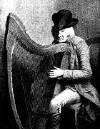

|

The portrait, c.1800, shows the harp without its distinctive eel head. As the overhanging neck is a "trompe l'oeil" effect - the harp has the usual ‘high headed’ construction where the forepillar continues to the top of the bass - the neck of the eel is on the short grain and could easily have broken. Presumably it was kept in the back of the soundbox, or O'Hampsey's coat pocket, and re-attached after his death when the harp was taken to the Downhill house, the home of his patron, Hervey-Bruce.

There are big splits in the belly of the harp. These have been repaired with iron straps running across the soundboard, which are visible in the portrait. These have since been removed, but their scars remain, including where the raised string band and the brass shoes have been neatly cut away to fit the straps.
Iron straps have also been fitted to join the neck to the soundbox, and to strengthen splits in the neck. There are other cracks in the top of the forepillar, and of cousrse the big crack where the eel head came off is still very visible.
The harp has been rather roughly treated in modern times, and has been rebuilt or repaired fairly recently, but not to usual museum or conservation standards, and detailed records or photographs were not kept of any such work done on it.